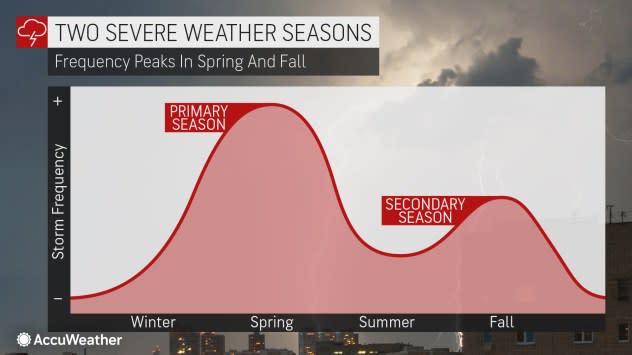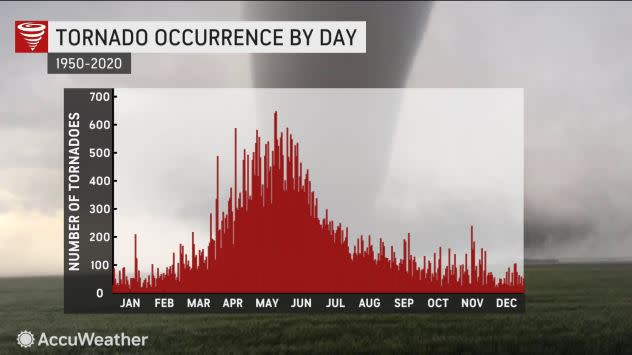There's a lesser-known secondary severe weather season: what to know
- Oops!Something went wrong.Please try again later.
 |
A larger peak of severe fall heralds the "second" severe weather season. |
Severe weather is commonly known to ramp up significantly in the spring and early summer. But the often overlooked secondary peak season during the fall is also worth watching out for.
October and November can bring just as many threats of tornadoes, damaging winds, flooding downpours and large hail as the spring occurrence.
Unlike the spring severe season, which happens from April to early June, the secondary season does not have exact dates, which could be one of the reasons it is not as well known, said AccuWeather Senior Weather Editor and Meteorologist Jesse Ferrell.
AccuWeather previously reported on the multiple peaks of tornado season which shows tornadoes spiking over the last months of the year, including major outbreaks in November 1989, 2005 and 2015.
Those outbreaks featured 1,499 tornadoes between the dates of Nov. 15 and 27. More specifically, Nov. 15 to 17 was a particularly bad three-day period in history with a total of 580 tornadoes.
AccuWeather Meteorologist Brandon Buckingham explained there has always been a secondary severe weather season, which happens as the Northern Hemisphere starts cooling off.
 |
Tornado season peaks in May, but smaller peaks can be observed during hurricane season in September and mid-November, the secondary severe weather season. |
"This has occurred in response to clashing air masses during the fall season," Buckingham said. "Cold air intruding southward from Canada clashes with warm and humid air in place from the tropics."
Buckingham said climate change could, to some degree, play a role in this, but to point out the exact and detailed impacts it has on severe weather is difficult.
The most common area in the United States for severe weather in the fall stretches from Texas to Georgia, including areas from the lower and middle Mississippi River Valley and the Midwest, Buckingham said.
"While this is the general focus area, severe weather can occur outside of this zone as well," Buckingham said. "Out west, severe thunderstorms are typically much less frequent. Oftentimes, areas west of the Front Range do not experience classic severe thunderstorms due to the Rockies blocking the plume of moisture coming from the Gulf of Mexico."
On Nov. 17, 2013, a tornado outbreak impacted Illinois, Indiana, Ohio and Kentucky. Including an EF4 tornado in Washington, Illinois, this marked the first recorded occurrence of a violent (EF3-EF5) tornado in the state during November, Buckingham said.
 |
FILE - An overturned tree sits in front of a tornado-damaged home in Mayfield, Ky., on Dec. 11, 2021. Gov. Andy Beshear traveled to an event in hard-hit Mayfield on Friday, June 10, 2022, to celebrate the first fully constructed new homes since the town took a direct hit from a tornado last December. (AP Photo/Mark Humphrey, File) |
More recently, a tornado outbreak on Dec. 10 and 11 in 2021 impacted the Midwest and mid-South. Mayfield, Kentucky, took a direct hit from a powerful EF4 tornado.
Buckingham said the main takeaway should be for people to never let their guard down.
"Severe weather can occur nearly anywhere at nearly any time of year," he said. "It is important always to have a way to receive weather warnings in your area and to have a plan of action in place if needed."
Want next-level safety, ad-free? Unlock advanced, hyperlocal severe weather alerts when you subscribe to Premium+ on the AccuWeather app. AccuWeather Alerts™ are prompted by our expert meteorologists who monitor and analyze dangerous weather risks 24/7 to keep you and your family safer.




